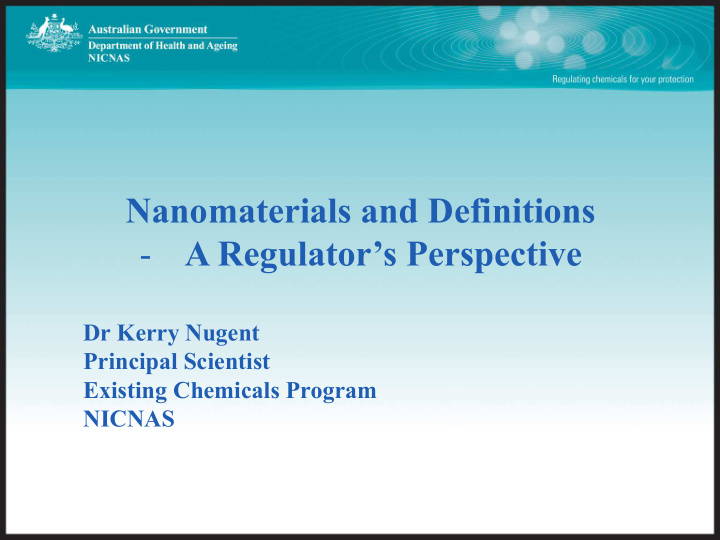



Nanomaterials and Definitions - A Regulator’s Perspective Dr Kerry Nugent Principal Scientist Existing Chemicals Program NICNAS
The regulatory need A strategy for the regulation of industrial nanomaterials uses a tiered approach: Tier 1: identify substances that should be captured within this strategy • “working definition” – substances enter into the regulatory framework Tier 2: risk assessment – further definitional refinement
Distinguishing one chemical from another • Chemical Identity – eg name, CAS number • Need for objective clarity in use of chemical identity – Each person using the identity information should get the same answer – Legal enforceability
Nanomaterial identity needs to account for: • “Sameness” – Need to identify when two nanomaterials have the same chemical identity • Existing Risk Assessment paradigms – Nanomaterial definitions should not imply need for nano-specific assessment when the material is better dealt with by an existing methodology – Need additional information
Sameness • A generic risk assessment covers all materials that are the same • For nanomaterials, the boundaries of “sameness” are not clear • Potentially enormous number of variables – Size, aspect ratio, surface morphology, surface chemistry…. – Toxicological significance????
Existing Risk Assessment paradigms • Many classes of chemicals that are currently risk assessed meet nanoscale definition – Globular proteins – Colloidal polymers – Large molecules • Nano-specific assessment methodologies likely to be less appropriate for these materials than existing methodologies – eg paint polymers – polymer of low concern
The NICNAS Working Definition • … industrial materials intentionally produced, manufactured or engineered to have unique properties or specific composition at the nanoscale, that is a size range typically between 1 nm and 100 nm, and is either a nano-object (i.e. that is confined in one, two, or three dimensions at the nanoscale) or is nanostructured (i.e. having an internal or surface structure at the nanoscale)”
Notes to the working definition • intentionally produced, manufactured or engineered materials are distinct from accidentally produced materials • ‘unique properties’ refers to chemical and/or physical properties that are different because of its nanoscale features as compared to the same material without nanoscale features, and result in unique phenomena (e.g. increased strength, chemical reactivity or conductivity) that enable novel applications. • aggregates and agglomerates are considered to be nanostructured substances • where a material includes 10% or more number of particles that meet the above definition (size, unique properties, intentionally produced) NICNAS will consider this to be a nanomaterial.
Considerations on the working definition • Chemical identity – Inherent in the definition • Objectiveness – “unique properties” is subjective • Sameness – Does not identify “sameness” • Existing Risk Assessment paradigms – Taken into account because of “unique properties”
ISO Definition Elements • Nanoscale is objective and highly relevant • Descriptive terms such as nanorod, nanoplate have relevance for “sameness” • Nanomaterial as any material with one or more dimensions in nanoscale not a good regulatory definition – “bycatch” (existing paradigms) – Does not address polydisperse materials
Recommend
More recommend